Taxation Law Report: Analysis of R&D Tax Incentives in Australia
VerifiedAdded on 2020/05/28
|10
|2766
|292
Report
AI Summary
This report delves into the research and development (R&D) tax incentives within Australian taxation law, focusing on how these incentives encourage small businesses to engage in R&D activities. It examines the role of the Australian Taxation Office (ATO) in providing tax offsets for eligible R&D activities, particularly highlighting the two core components relevant to small companies: tax offsets and non-refundable tax offsets. The report discusses the "taxation ruling of TR 92/2" and its application of section 73A, detailing the types of expenditure eligible for deductions, the conditions for claiming deductions, and the importance of maintaining proper business records to substantiate R&D expenses. It also covers specific provisions regarding payments to approved research institutes and expenses of capital nature, while also addressing the ATO's concerns about improper claims and related-party transactions. The report concludes by emphasizing that R&D activities must be directly associated with core research to qualify for tax incentives and underscores the importance of documenting decisions made during self-assessment activities. This represents a comprehensive analysis of the tax benefits provided by the Australian government to businesses undertaking research and development.
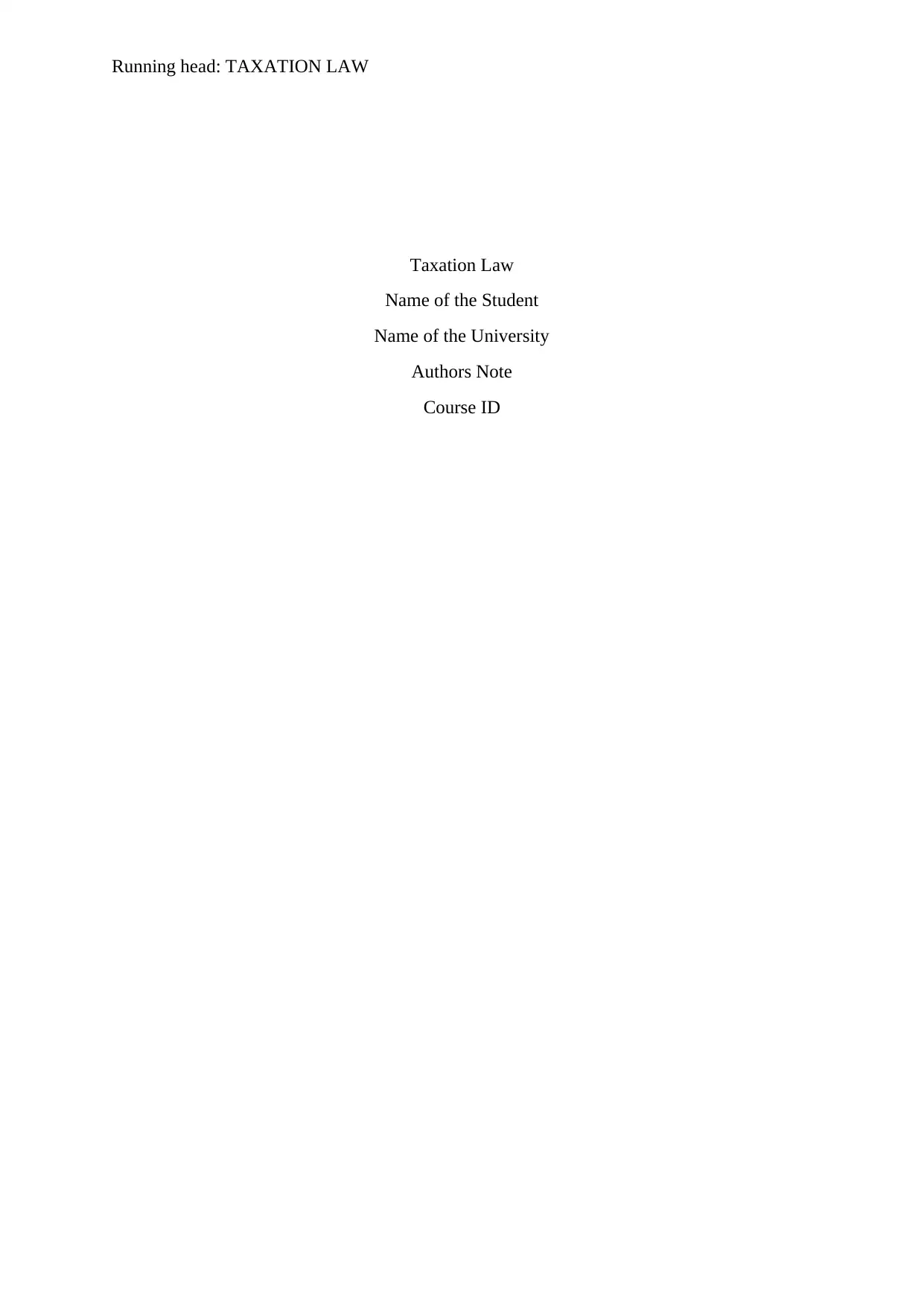
Running head: TAXATION LAW
Taxation Law
Name of the Student
Name of the University
Authors Note
Course ID
Taxation Law
Name of the Student
Name of the University
Authors Note
Course ID
Paraphrase This Document
Need a fresh take? Get an instant paraphrase of this document with our AI Paraphraser
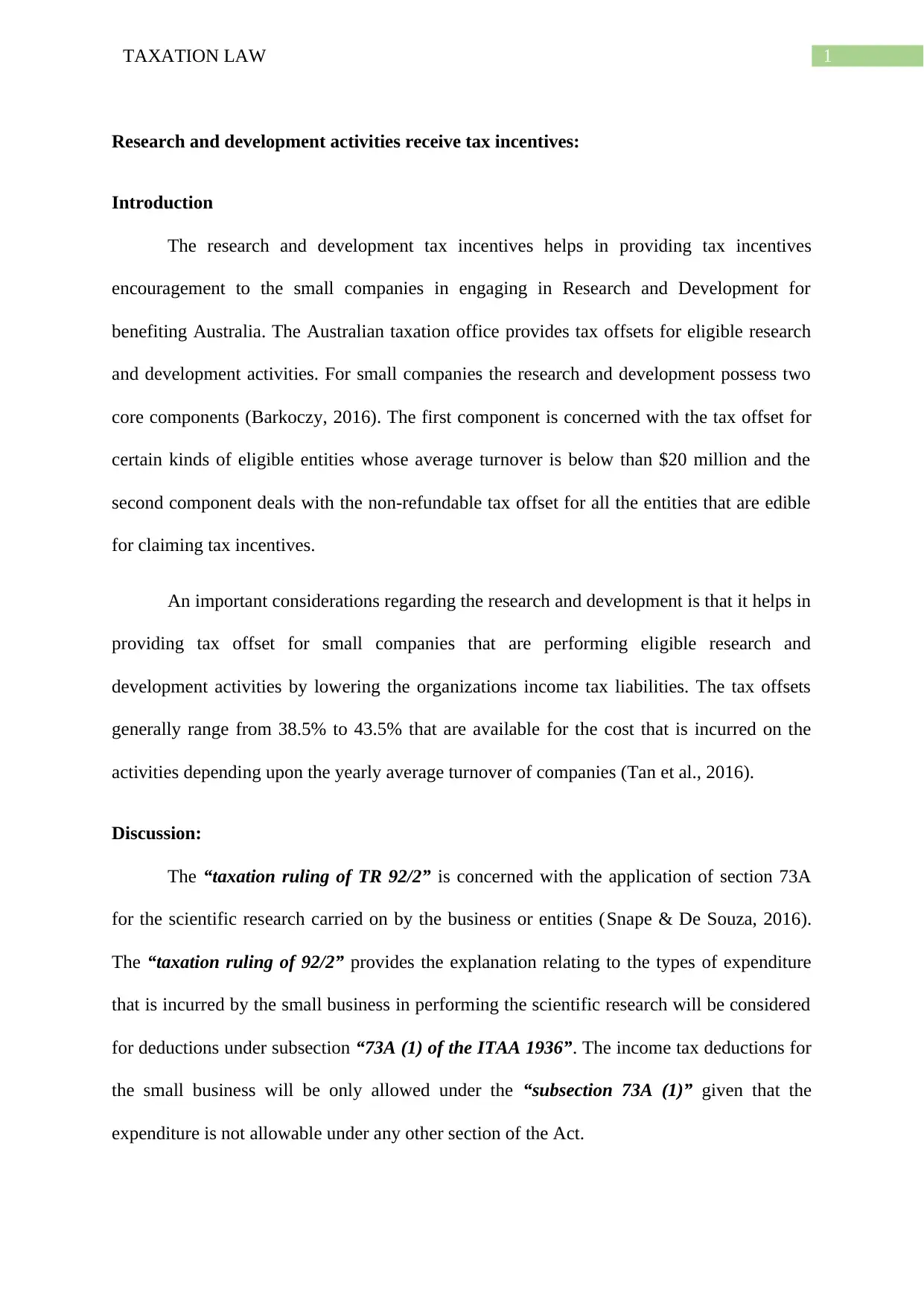
1TAXATION LAW
Research and development activities receive tax incentives:
Introduction
The research and development tax incentives helps in providing tax incentives
encouragement to the small companies in engaging in Research and Development for
benefiting Australia. The Australian taxation office provides tax offsets for eligible research
and development activities. For small companies the research and development possess two
core components (Barkoczy, 2016). The first component is concerned with the tax offset for
certain kinds of eligible entities whose average turnover is below than $20 million and the
second component deals with the non-refundable tax offset for all the entities that are edible
for claiming tax incentives.
An important considerations regarding the research and development is that it helps in
providing tax offset for small companies that are performing eligible research and
development activities by lowering the organizations income tax liabilities. The tax offsets
generally range from 38.5% to 43.5% that are available for the cost that is incurred on the
activities depending upon the yearly average turnover of companies (Tan et al., 2016).
Discussion:
The “taxation ruling of TR 92/2” is concerned with the application of section 73A
for the scientific research carried on by the business or entities (Snape & De Souza, 2016).
The “taxation ruling of 92/2” provides the explanation relating to the types of expenditure
that is incurred by the small business in performing the scientific research will be considered
for deductions under subsection “73A (1) of the ITAA 1936”. The income tax deductions for
the small business will be only allowed under the “subsection 73A (1)” given that the
expenditure is not allowable under any other section of the Act.
Research and development activities receive tax incentives:
Introduction
The research and development tax incentives helps in providing tax incentives
encouragement to the small companies in engaging in Research and Development for
benefiting Australia. The Australian taxation office provides tax offsets for eligible research
and development activities. For small companies the research and development possess two
core components (Barkoczy, 2016). The first component is concerned with the tax offset for
certain kinds of eligible entities whose average turnover is below than $20 million and the
second component deals with the non-refundable tax offset for all the entities that are edible
for claiming tax incentives.
An important considerations regarding the research and development is that it helps in
providing tax offset for small companies that are performing eligible research and
development activities by lowering the organizations income tax liabilities. The tax offsets
generally range from 38.5% to 43.5% that are available for the cost that is incurred on the
activities depending upon the yearly average turnover of companies (Tan et al., 2016).
Discussion:
The “taxation ruling of TR 92/2” is concerned with the application of section 73A
for the scientific research carried on by the business or entities (Snape & De Souza, 2016).
The “taxation ruling of 92/2” provides the explanation relating to the types of expenditure
that is incurred by the small business in performing the scientific research will be considered
for deductions under subsection “73A (1) of the ITAA 1936”. The income tax deductions for
the small business will be only allowed under the “subsection 73A (1)” given that the
expenditure is not allowable under any other section of the Act.
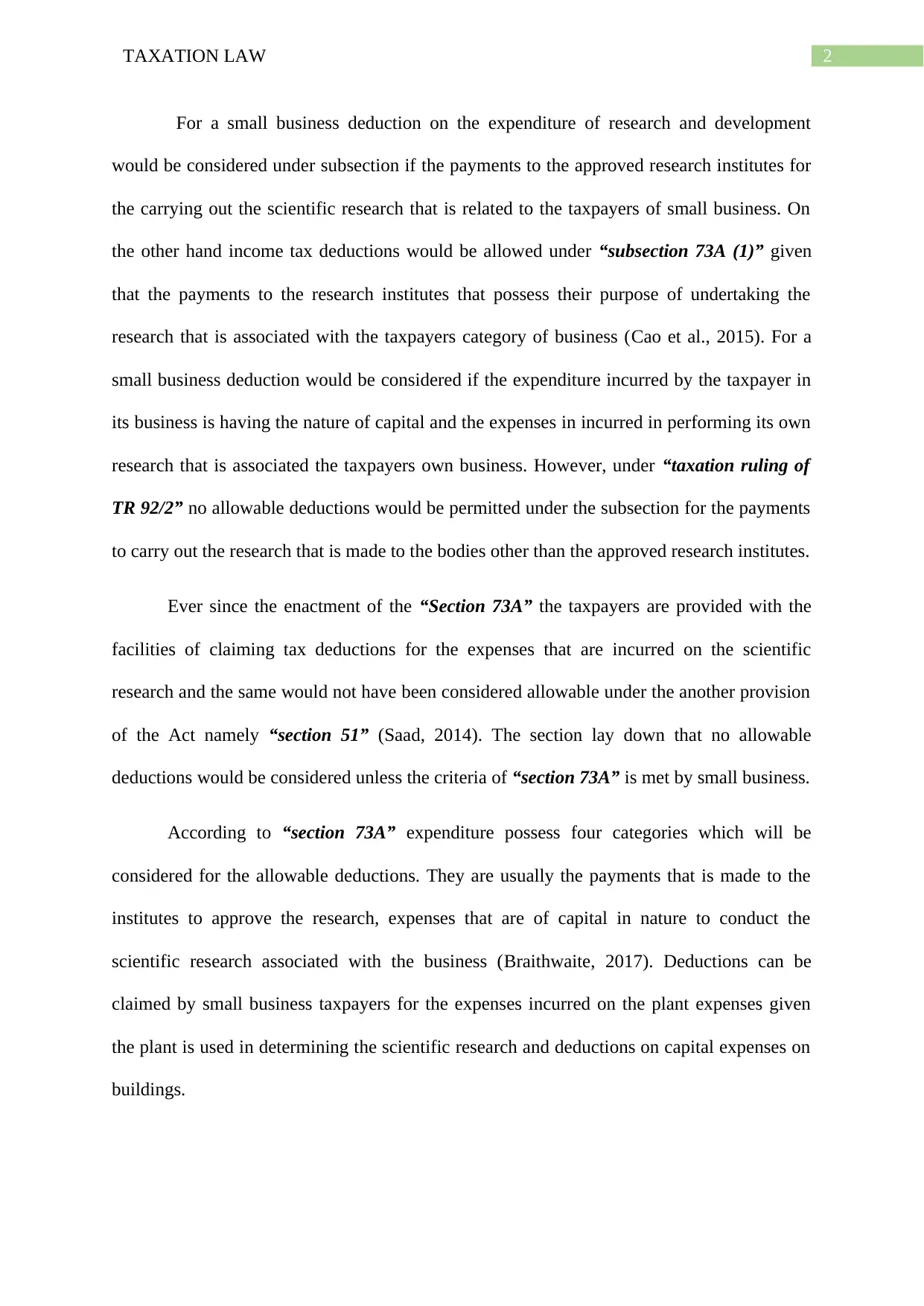
2TAXATION LAW
For a small business deduction on the expenditure of research and development
would be considered under subsection if the payments to the approved research institutes for
the carrying out the scientific research that is related to the taxpayers of small business. On
the other hand income tax deductions would be allowed under “subsection 73A (1)” given
that the payments to the research institutes that possess their purpose of undertaking the
research that is associated with the taxpayers category of business (Cao et al., 2015). For a
small business deduction would be considered if the expenditure incurred by the taxpayer in
its business is having the nature of capital and the expenses in incurred in performing its own
research that is associated the taxpayers own business. However, under “taxation ruling of
TR 92/2” no allowable deductions would be permitted under the subsection for the payments
to carry out the research that is made to the bodies other than the approved research institutes.
Ever since the enactment of the “Section 73A” the taxpayers are provided with the
facilities of claiming tax deductions for the expenses that are incurred on the scientific
research and the same would not have been considered allowable under the another provision
of the Act namely “section 51” (Saad, 2014). The section lay down that no allowable
deductions would be considered unless the criteria of “section 73A” is met by small business.
According to “section 73A” expenditure possess four categories which will be
considered for the allowable deductions. They are usually the payments that is made to the
institutes to approve the research, expenses that are of capital in nature to conduct the
scientific research associated with the business (Braithwaite, 2017). Deductions can be
claimed by small business taxpayers for the expenses incurred on the plant expenses given
the plant is used in determining the scientific research and deductions on capital expenses on
buildings.
For a small business deduction on the expenditure of research and development
would be considered under subsection if the payments to the approved research institutes for
the carrying out the scientific research that is related to the taxpayers of small business. On
the other hand income tax deductions would be allowed under “subsection 73A (1)” given
that the payments to the research institutes that possess their purpose of undertaking the
research that is associated with the taxpayers category of business (Cao et al., 2015). For a
small business deduction would be considered if the expenditure incurred by the taxpayer in
its business is having the nature of capital and the expenses in incurred in performing its own
research that is associated the taxpayers own business. However, under “taxation ruling of
TR 92/2” no allowable deductions would be permitted under the subsection for the payments
to carry out the research that is made to the bodies other than the approved research institutes.
Ever since the enactment of the “Section 73A” the taxpayers are provided with the
facilities of claiming tax deductions for the expenses that are incurred on the scientific
research and the same would not have been considered allowable under the another provision
of the Act namely “section 51” (Saad, 2014). The section lay down that no allowable
deductions would be considered unless the criteria of “section 73A” is met by small business.
According to “section 73A” expenditure possess four categories which will be
considered for the allowable deductions. They are usually the payments that is made to the
institutes to approve the research, expenses that are of capital in nature to conduct the
scientific research associated with the business (Braithwaite, 2017). Deductions can be
claimed by small business taxpayers for the expenses incurred on the plant expenses given
the plant is used in determining the scientific research and deductions on capital expenses on
buildings.
⊘ This is a preview!⊘
Do you want full access?
Subscribe today to unlock all pages.

Trusted by 1+ million students worldwide
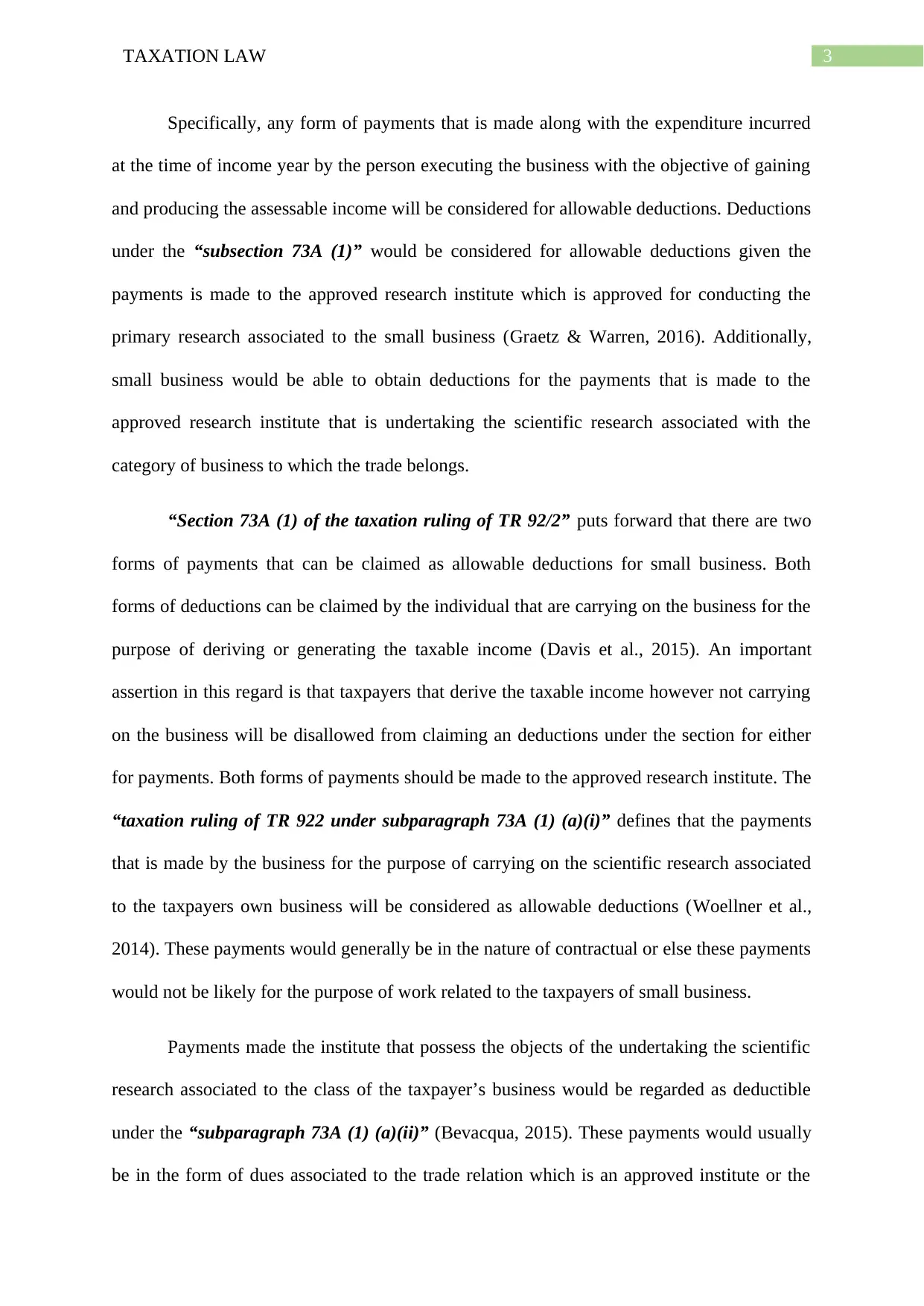
3TAXATION LAW
Specifically, any form of payments that is made along with the expenditure incurred
at the time of income year by the person executing the business with the objective of gaining
and producing the assessable income will be considered for allowable deductions. Deductions
under the “subsection 73A (1)” would be considered for allowable deductions given the
payments is made to the approved research institute which is approved for conducting the
primary research associated to the small business (Graetz & Warren, 2016). Additionally,
small business would be able to obtain deductions for the payments that is made to the
approved research institute that is undertaking the scientific research associated with the
category of business to which the trade belongs.
“Section 73A (1) of the taxation ruling of TR 92/2” puts forward that there are two
forms of payments that can be claimed as allowable deductions for small business. Both
forms of deductions can be claimed by the individual that are carrying on the business for the
purpose of deriving or generating the taxable income (Davis et al., 2015). An important
assertion in this regard is that taxpayers that derive the taxable income however not carrying
on the business will be disallowed from claiming an deductions under the section for either
for payments. Both forms of payments should be made to the approved research institute. The
“taxation ruling of TR 922 under subparagraph 73A (1) (a)(i)” defines that the payments
that is made by the business for the purpose of carrying on the scientific research associated
to the taxpayers own business will be considered as allowable deductions (Woellner et al.,
2014). These payments would generally be in the nature of contractual or else these payments
would not be likely for the purpose of work related to the taxpayers of small business.
Payments made the institute that possess the objects of the undertaking the scientific
research associated to the class of the taxpayer’s business would be regarded as deductible
under the “subparagraph 73A (1) (a)(ii)” (Bevacqua, 2015). These payments would usually
be in the form of dues associated to the trade relation which is an approved institute or the
Specifically, any form of payments that is made along with the expenditure incurred
at the time of income year by the person executing the business with the objective of gaining
and producing the assessable income will be considered for allowable deductions. Deductions
under the “subsection 73A (1)” would be considered for allowable deductions given the
payments is made to the approved research institute which is approved for conducting the
primary research associated to the small business (Graetz & Warren, 2016). Additionally,
small business would be able to obtain deductions for the payments that is made to the
approved research institute that is undertaking the scientific research associated with the
category of business to which the trade belongs.
“Section 73A (1) of the taxation ruling of TR 92/2” puts forward that there are two
forms of payments that can be claimed as allowable deductions for small business. Both
forms of deductions can be claimed by the individual that are carrying on the business for the
purpose of deriving or generating the taxable income (Davis et al., 2015). An important
assertion in this regard is that taxpayers that derive the taxable income however not carrying
on the business will be disallowed from claiming an deductions under the section for either
for payments. Both forms of payments should be made to the approved research institute. The
“taxation ruling of TR 922 under subparagraph 73A (1) (a)(i)” defines that the payments
that is made by the business for the purpose of carrying on the scientific research associated
to the taxpayers own business will be considered as allowable deductions (Woellner et al.,
2014). These payments would generally be in the nature of contractual or else these payments
would not be likely for the purpose of work related to the taxpayers of small business.
Payments made the institute that possess the objects of the undertaking the scientific
research associated to the class of the taxpayer’s business would be regarded as deductible
under the “subparagraph 73A (1) (a)(ii)” (Bevacqua, 2015). These payments would usually
be in the form of dues associated to the trade relation which is an approved institute or the
Paraphrase This Document
Need a fresh take? Get an instant paraphrase of this document with our AI Paraphraser
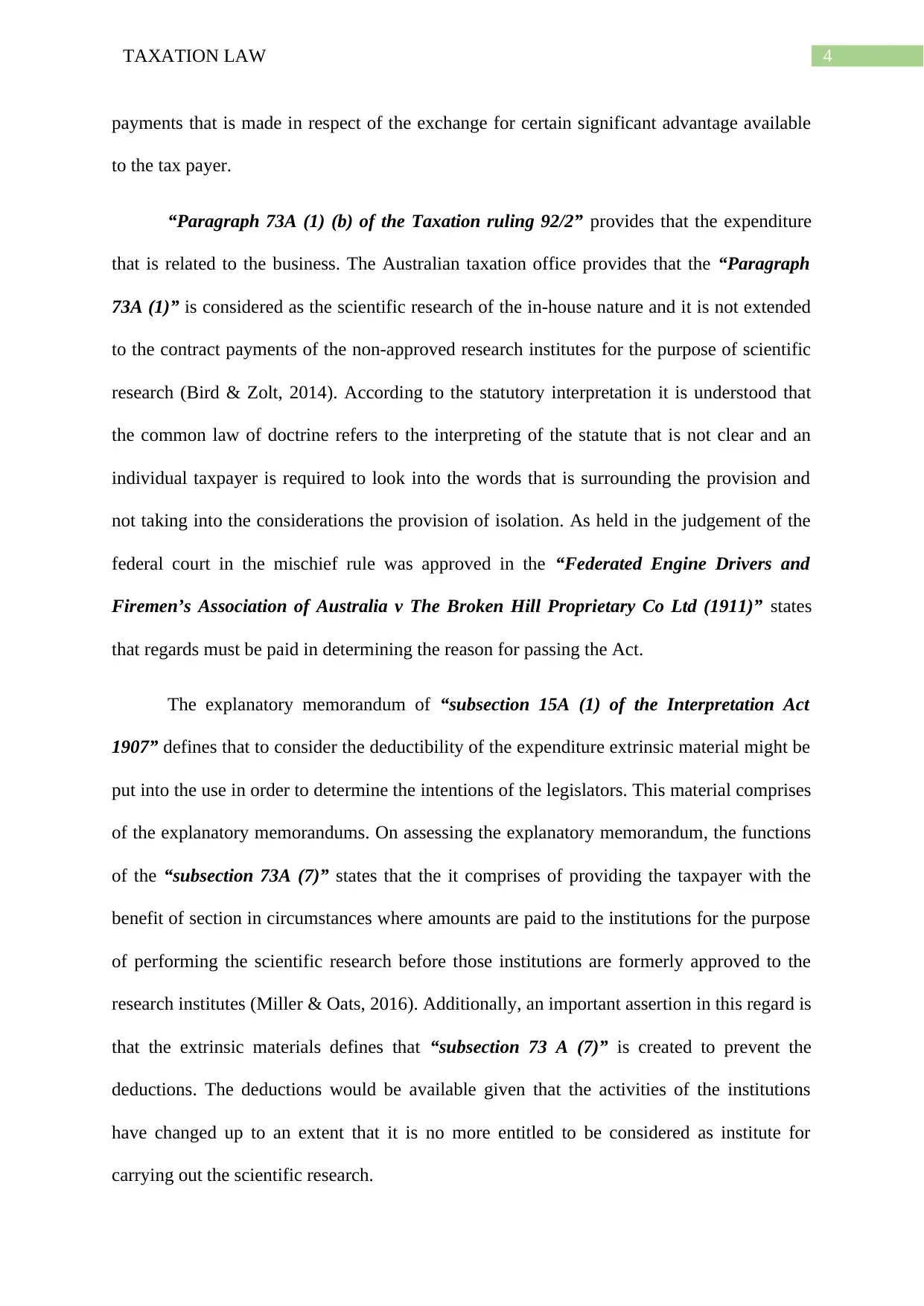
4TAXATION LAW
payments that is made in respect of the exchange for certain significant advantage available
to the tax payer.
“Paragraph 73A (1) (b) of the Taxation ruling 92/2” provides that the expenditure
that is related to the business. The Australian taxation office provides that the “Paragraph
73A (1)” is considered as the scientific research of the in-house nature and it is not extended
to the contract payments of the non-approved research institutes for the purpose of scientific
research (Bird & Zolt, 2014). According to the statutory interpretation it is understood that
the common law of doctrine refers to the interpreting of the statute that is not clear and an
individual taxpayer is required to look into the words that is surrounding the provision and
not taking into the considerations the provision of isolation. As held in the judgement of the
federal court in the mischief rule was approved in the “Federated Engine Drivers and
Firemen’s Association of Australia v The Broken Hill Proprietary Co Ltd (1911)” states
that regards must be paid in determining the reason for passing the Act.
The explanatory memorandum of “subsection 15A (1) of the Interpretation Act
1907” defines that to consider the deductibility of the expenditure extrinsic material might be
put into the use in order to determine the intentions of the legislators. This material comprises
of the explanatory memorandums. On assessing the explanatory memorandum, the functions
of the “subsection 73A (7)” states that the it comprises of providing the taxpayer with the
benefit of section in circumstances where amounts are paid to the institutions for the purpose
of performing the scientific research before those institutions are formerly approved to the
research institutes (Miller & Oats, 2016). Additionally, an important assertion in this regard is
that the extrinsic materials defines that “subsection 73 A (7)” is created to prevent the
deductions. The deductions would be available given that the activities of the institutions
have changed up to an extent that it is no more entitled to be considered as institute for
carrying out the scientific research.
payments that is made in respect of the exchange for certain significant advantage available
to the tax payer.
“Paragraph 73A (1) (b) of the Taxation ruling 92/2” provides that the expenditure
that is related to the business. The Australian taxation office provides that the “Paragraph
73A (1)” is considered as the scientific research of the in-house nature and it is not extended
to the contract payments of the non-approved research institutes for the purpose of scientific
research (Bird & Zolt, 2014). According to the statutory interpretation it is understood that
the common law of doctrine refers to the interpreting of the statute that is not clear and an
individual taxpayer is required to look into the words that is surrounding the provision and
not taking into the considerations the provision of isolation. As held in the judgement of the
federal court in the mischief rule was approved in the “Federated Engine Drivers and
Firemen’s Association of Australia v The Broken Hill Proprietary Co Ltd (1911)” states
that regards must be paid in determining the reason for passing the Act.
The explanatory memorandum of “subsection 15A (1) of the Interpretation Act
1907” defines that to consider the deductibility of the expenditure extrinsic material might be
put into the use in order to determine the intentions of the legislators. This material comprises
of the explanatory memorandums. On assessing the explanatory memorandum, the functions
of the “subsection 73A (7)” states that the it comprises of providing the taxpayer with the
benefit of section in circumstances where amounts are paid to the institutions for the purpose
of performing the scientific research before those institutions are formerly approved to the
research institutes (Miller & Oats, 2016). Additionally, an important assertion in this regard is
that the extrinsic materials defines that “subsection 73 A (7)” is created to prevent the
deductions. The deductions would be available given that the activities of the institutions
have changed up to an extent that it is no more entitled to be considered as institute for
carrying out the scientific research.
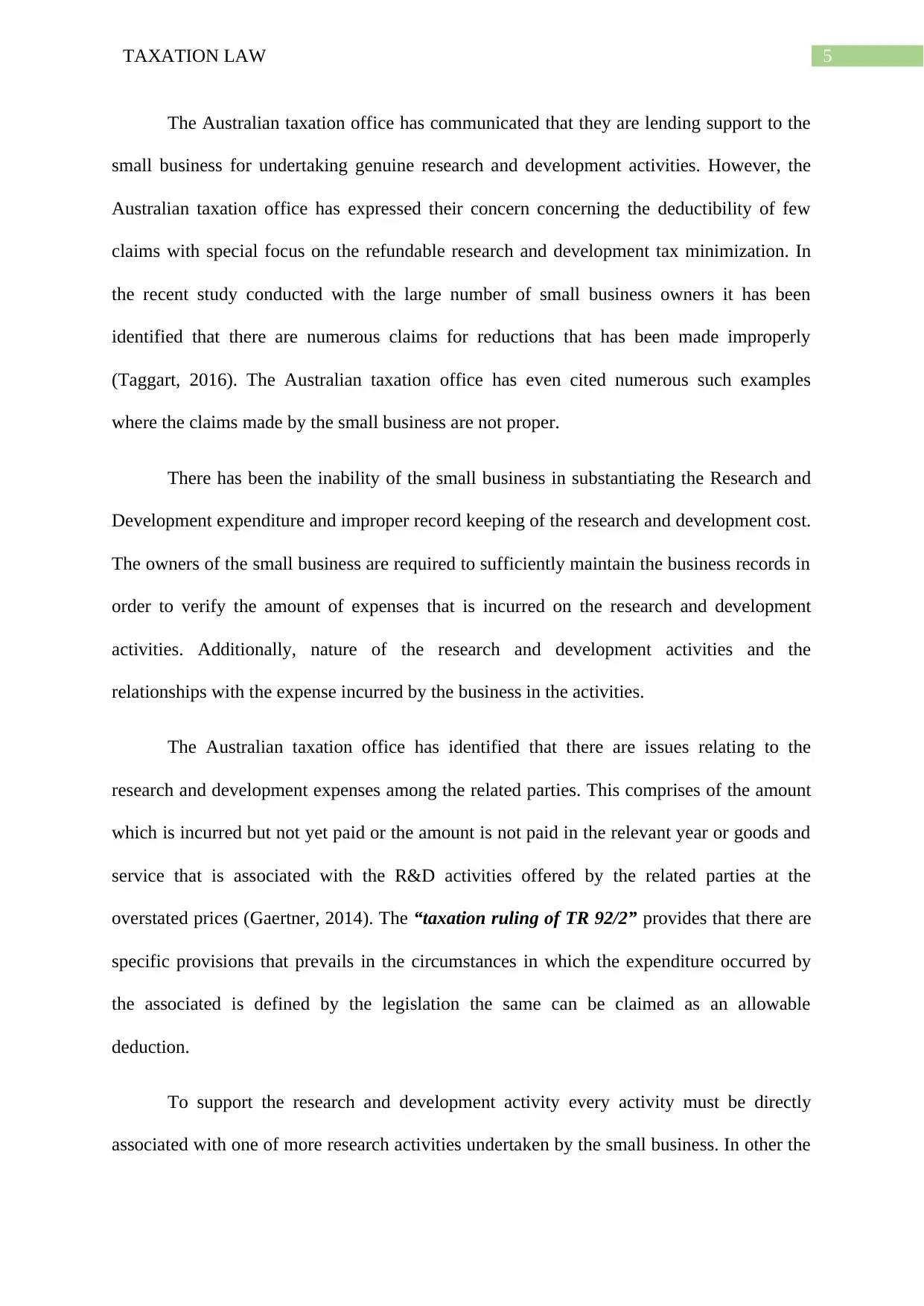
5TAXATION LAW
The Australian taxation office has communicated that they are lending support to the
small business for undertaking genuine research and development activities. However, the
Australian taxation office has expressed their concern concerning the deductibility of few
claims with special focus on the refundable research and development tax minimization. In
the recent study conducted with the large number of small business owners it has been
identified that there are numerous claims for reductions that has been made improperly
(Taggart, 2016). The Australian taxation office has even cited numerous such examples
where the claims made by the small business are not proper.
There has been the inability of the small business in substantiating the Research and
Development expenditure and improper record keeping of the research and development cost.
The owners of the small business are required to sufficiently maintain the business records in
order to verify the amount of expenses that is incurred on the research and development
activities. Additionally, nature of the research and development activities and the
relationships with the expense incurred by the business in the activities.
The Australian taxation office has identified that there are issues relating to the
research and development expenses among the related parties. This comprises of the amount
which is incurred but not yet paid or the amount is not paid in the relevant year or goods and
service that is associated with the R&D activities offered by the related parties at the
overstated prices (Gaertner, 2014). The “taxation ruling of TR 92/2” provides that there are
specific provisions that prevails in the circumstances in which the expenditure occurred by
the associated is defined by the legislation the same can be claimed as an allowable
deduction.
To support the research and development activity every activity must be directly
associated with one of more research activities undertaken by the small business. In other the
The Australian taxation office has communicated that they are lending support to the
small business for undertaking genuine research and development activities. However, the
Australian taxation office has expressed their concern concerning the deductibility of few
claims with special focus on the refundable research and development tax minimization. In
the recent study conducted with the large number of small business owners it has been
identified that there are numerous claims for reductions that has been made improperly
(Taggart, 2016). The Australian taxation office has even cited numerous such examples
where the claims made by the small business are not proper.
There has been the inability of the small business in substantiating the Research and
Development expenditure and improper record keeping of the research and development cost.
The owners of the small business are required to sufficiently maintain the business records in
order to verify the amount of expenses that is incurred on the research and development
activities. Additionally, nature of the research and development activities and the
relationships with the expense incurred by the business in the activities.
The Australian taxation office has identified that there are issues relating to the
research and development expenses among the related parties. This comprises of the amount
which is incurred but not yet paid or the amount is not paid in the relevant year or goods and
service that is associated with the R&D activities offered by the related parties at the
overstated prices (Gaertner, 2014). The “taxation ruling of TR 92/2” provides that there are
specific provisions that prevails in the circumstances in which the expenditure occurred by
the associated is defined by the legislation the same can be claimed as an allowable
deduction.
To support the research and development activity every activity must be directly
associated with one of more research activities undertaken by the small business. In other the
⊘ This is a preview!⊘
Do you want full access?
Subscribe today to unlock all pages.

Trusted by 1+ million students worldwide
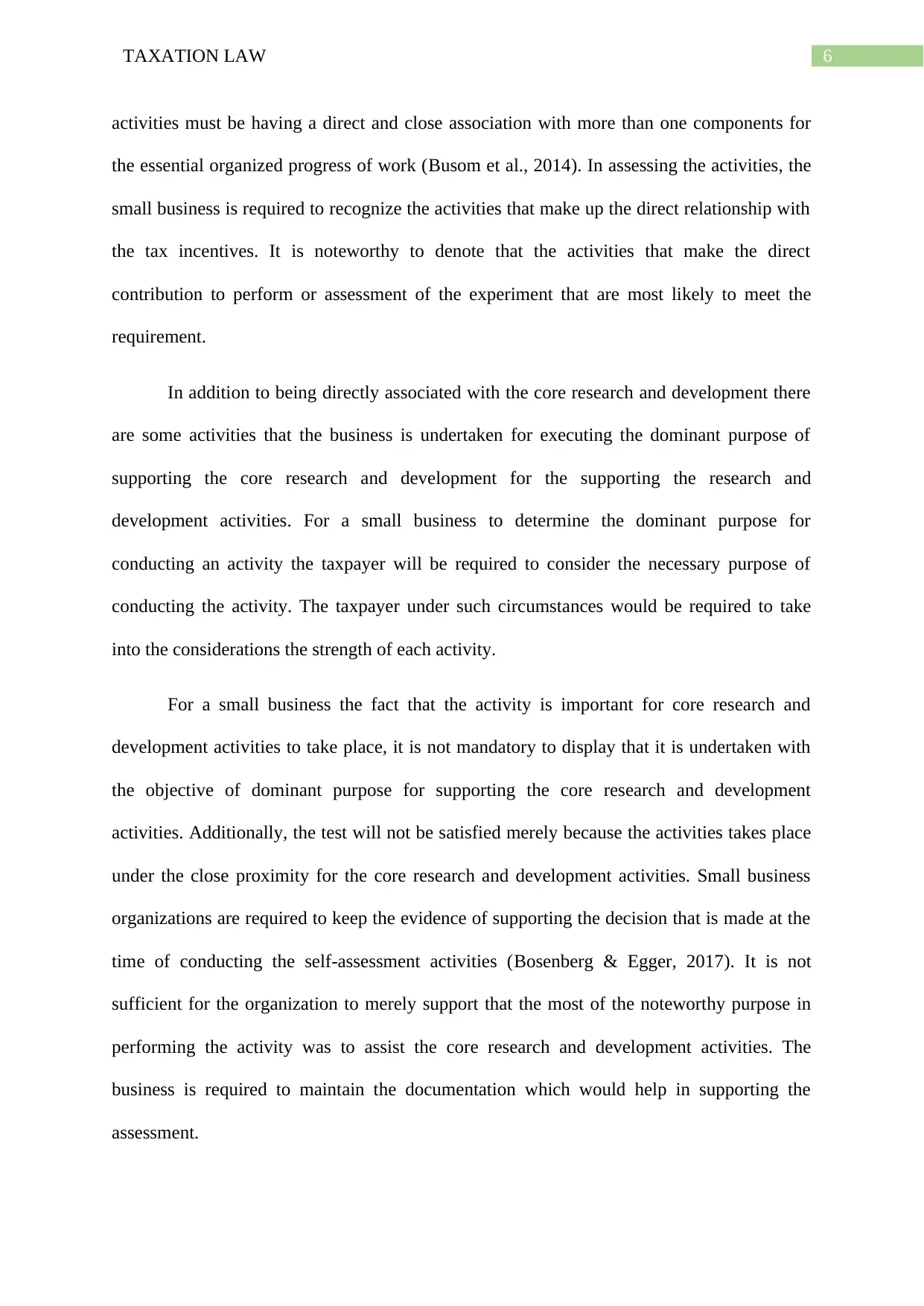
6TAXATION LAW
activities must be having a direct and close association with more than one components for
the essential organized progress of work (Busom et al., 2014). In assessing the activities, the
small business is required to recognize the activities that make up the direct relationship with
the tax incentives. It is noteworthy to denote that the activities that make the direct
contribution to perform or assessment of the experiment that are most likely to meet the
requirement.
In addition to being directly associated with the core research and development there
are some activities that the business is undertaken for executing the dominant purpose of
supporting the core research and development for the supporting the research and
development activities. For a small business to determine the dominant purpose for
conducting an activity the taxpayer will be required to consider the necessary purpose of
conducting the activity. The taxpayer under such circumstances would be required to take
into the considerations the strength of each activity.
For a small business the fact that the activity is important for core research and
development activities to take place, it is not mandatory to display that it is undertaken with
the objective of dominant purpose for supporting the core research and development
activities. Additionally, the test will not be satisfied merely because the activities takes place
under the close proximity for the core research and development activities. Small business
organizations are required to keep the evidence of supporting the decision that is made at the
time of conducting the self-assessment activities (Bosenberg & Egger, 2017). It is not
sufficient for the organization to merely support that the most of the noteworthy purpose in
performing the activity was to assist the core research and development activities. The
business is required to maintain the documentation which would help in supporting the
assessment.
activities must be having a direct and close association with more than one components for
the essential organized progress of work (Busom et al., 2014). In assessing the activities, the
small business is required to recognize the activities that make up the direct relationship with
the tax incentives. It is noteworthy to denote that the activities that make the direct
contribution to perform or assessment of the experiment that are most likely to meet the
requirement.
In addition to being directly associated with the core research and development there
are some activities that the business is undertaken for executing the dominant purpose of
supporting the core research and development for the supporting the research and
development activities. For a small business to determine the dominant purpose for
conducting an activity the taxpayer will be required to consider the necessary purpose of
conducting the activity. The taxpayer under such circumstances would be required to take
into the considerations the strength of each activity.
For a small business the fact that the activity is important for core research and
development activities to take place, it is not mandatory to display that it is undertaken with
the objective of dominant purpose for supporting the core research and development
activities. Additionally, the test will not be satisfied merely because the activities takes place
under the close proximity for the core research and development activities. Small business
organizations are required to keep the evidence of supporting the decision that is made at the
time of conducting the self-assessment activities (Bosenberg & Egger, 2017). It is not
sufficient for the organization to merely support that the most of the noteworthy purpose in
performing the activity was to assist the core research and development activities. The
business is required to maintain the documentation which would help in supporting the
assessment.
Paraphrase This Document
Need a fresh take? Get an instant paraphrase of this document with our AI Paraphraser
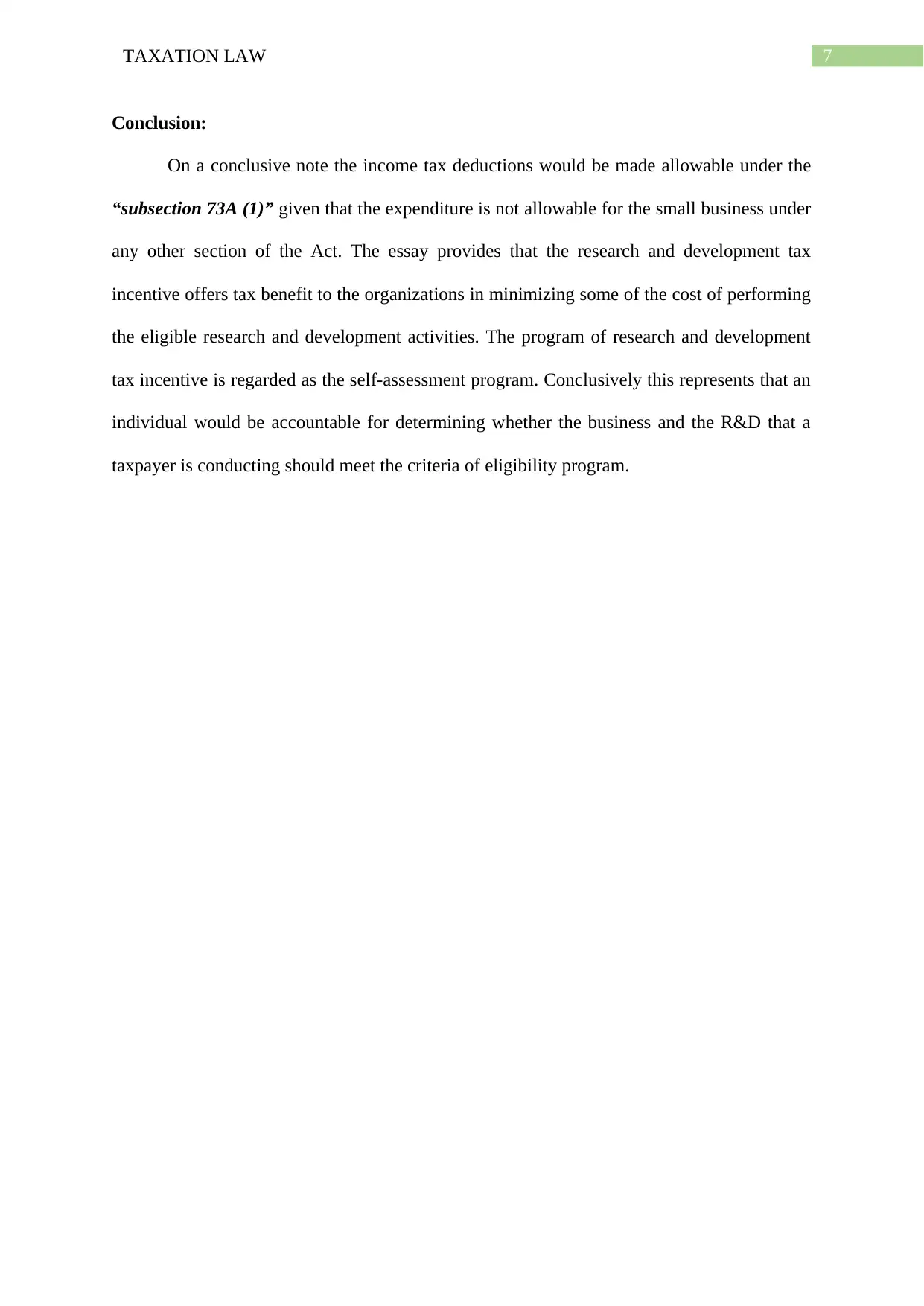
7TAXATION LAW
Conclusion:
On a conclusive note the income tax deductions would be made allowable under the
“subsection 73A (1)” given that the expenditure is not allowable for the small business under
any other section of the Act. The essay provides that the research and development tax
incentive offers tax benefit to the organizations in minimizing some of the cost of performing
the eligible research and development activities. The program of research and development
tax incentive is regarded as the self-assessment program. Conclusively this represents that an
individual would be accountable for determining whether the business and the R&D that a
taxpayer is conducting should meet the criteria of eligibility program.
Conclusion:
On a conclusive note the income tax deductions would be made allowable under the
“subsection 73A (1)” given that the expenditure is not allowable for the small business under
any other section of the Act. The essay provides that the research and development tax
incentive offers tax benefit to the organizations in minimizing some of the cost of performing
the eligible research and development activities. The program of research and development
tax incentive is regarded as the self-assessment program. Conclusively this represents that an
individual would be accountable for determining whether the business and the R&D that a
taxpayer is conducting should meet the criteria of eligibility program.
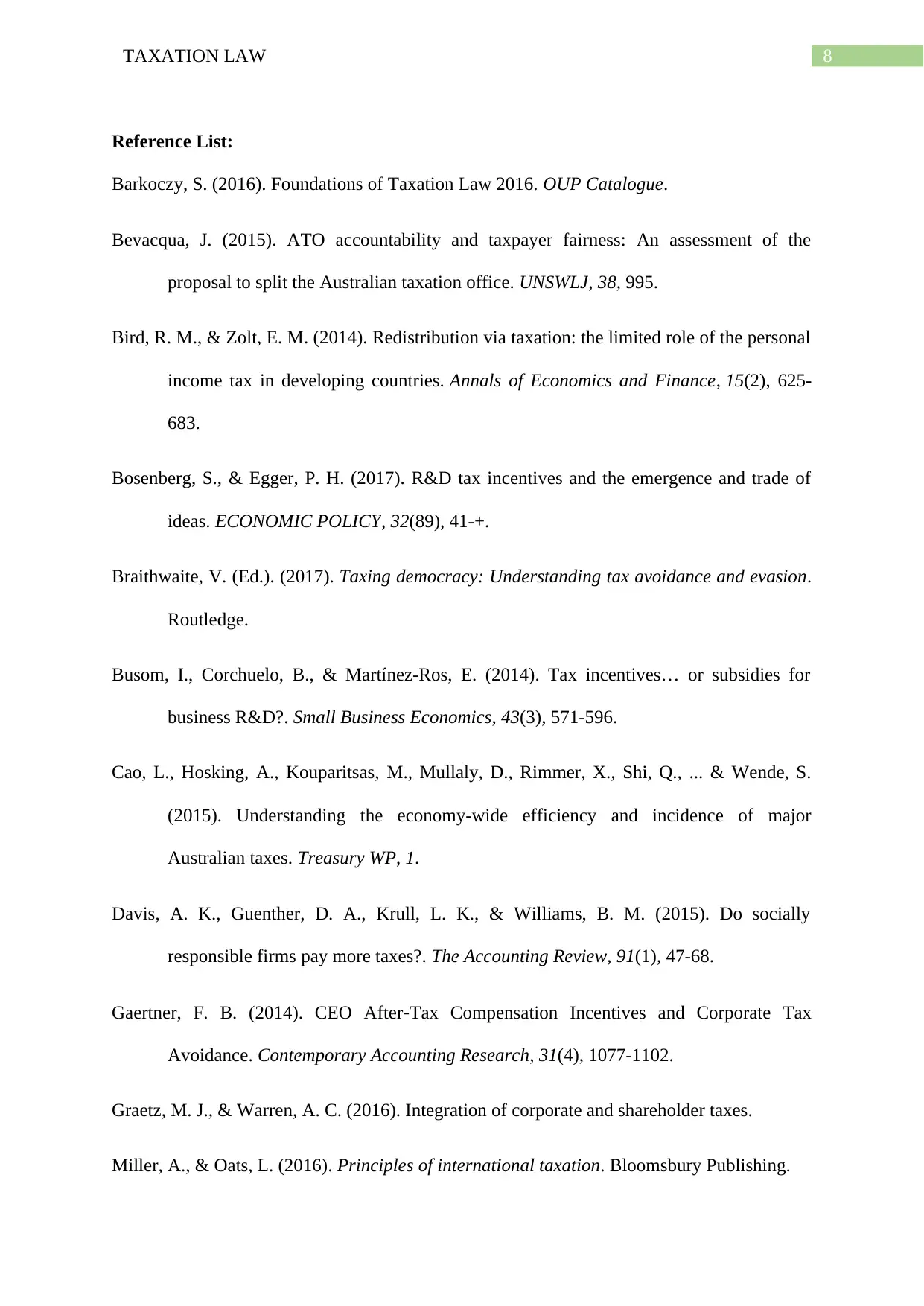
8TAXATION LAW
Reference List:
Barkoczy, S. (2016). Foundations of Taxation Law 2016. OUP Catalogue.
Bevacqua, J. (2015). ATO accountability and taxpayer fairness: An assessment of the
proposal to split the Australian taxation office. UNSWLJ, 38, 995.
Bird, R. M., & Zolt, E. M. (2014). Redistribution via taxation: the limited role of the personal
income tax in developing countries. Annals of Economics and Finance, 15(2), 625-
683.
Bosenberg, S., & Egger, P. H. (2017). R&D tax incentives and the emergence and trade of
ideas. ECONOMIC POLICY, 32(89), 41-+.
Braithwaite, V. (Ed.). (2017). Taxing democracy: Understanding tax avoidance and evasion.
Routledge.
Busom, I., Corchuelo, B., & Martínez-Ros, E. (2014). Tax incentives… or subsidies for
business R&D?. Small Business Economics, 43(3), 571-596.
Cao, L., Hosking, A., Kouparitsas, M., Mullaly, D., Rimmer, X., Shi, Q., ... & Wende, S.
(2015). Understanding the economy-wide efficiency and incidence of major
Australian taxes. Treasury WP, 1.
Davis, A. K., Guenther, D. A., Krull, L. K., & Williams, B. M. (2015). Do socially
responsible firms pay more taxes?. The Accounting Review, 91(1), 47-68.
Gaertner, F. B. (2014). CEO After‐Tax Compensation Incentives and Corporate Tax
Avoidance. Contemporary Accounting Research, 31(4), 1077-1102.
Graetz, M. J., & Warren, A. C. (2016). Integration of corporate and shareholder taxes.
Miller, A., & Oats, L. (2016). Principles of international taxation. Bloomsbury Publishing.
Reference List:
Barkoczy, S. (2016). Foundations of Taxation Law 2016. OUP Catalogue.
Bevacqua, J. (2015). ATO accountability and taxpayer fairness: An assessment of the
proposal to split the Australian taxation office. UNSWLJ, 38, 995.
Bird, R. M., & Zolt, E. M. (2014). Redistribution via taxation: the limited role of the personal
income tax in developing countries. Annals of Economics and Finance, 15(2), 625-
683.
Bosenberg, S., & Egger, P. H. (2017). R&D tax incentives and the emergence and trade of
ideas. ECONOMIC POLICY, 32(89), 41-+.
Braithwaite, V. (Ed.). (2017). Taxing democracy: Understanding tax avoidance and evasion.
Routledge.
Busom, I., Corchuelo, B., & Martínez-Ros, E. (2014). Tax incentives… or subsidies for
business R&D?. Small Business Economics, 43(3), 571-596.
Cao, L., Hosking, A., Kouparitsas, M., Mullaly, D., Rimmer, X., Shi, Q., ... & Wende, S.
(2015). Understanding the economy-wide efficiency and incidence of major
Australian taxes. Treasury WP, 1.
Davis, A. K., Guenther, D. A., Krull, L. K., & Williams, B. M. (2015). Do socially
responsible firms pay more taxes?. The Accounting Review, 91(1), 47-68.
Gaertner, F. B. (2014). CEO After‐Tax Compensation Incentives and Corporate Tax
Avoidance. Contemporary Accounting Research, 31(4), 1077-1102.
Graetz, M. J., & Warren, A. C. (2016). Integration of corporate and shareholder taxes.
Miller, A., & Oats, L. (2016). Principles of international taxation. Bloomsbury Publishing.
⊘ This is a preview!⊘
Do you want full access?
Subscribe today to unlock all pages.

Trusted by 1+ million students worldwide
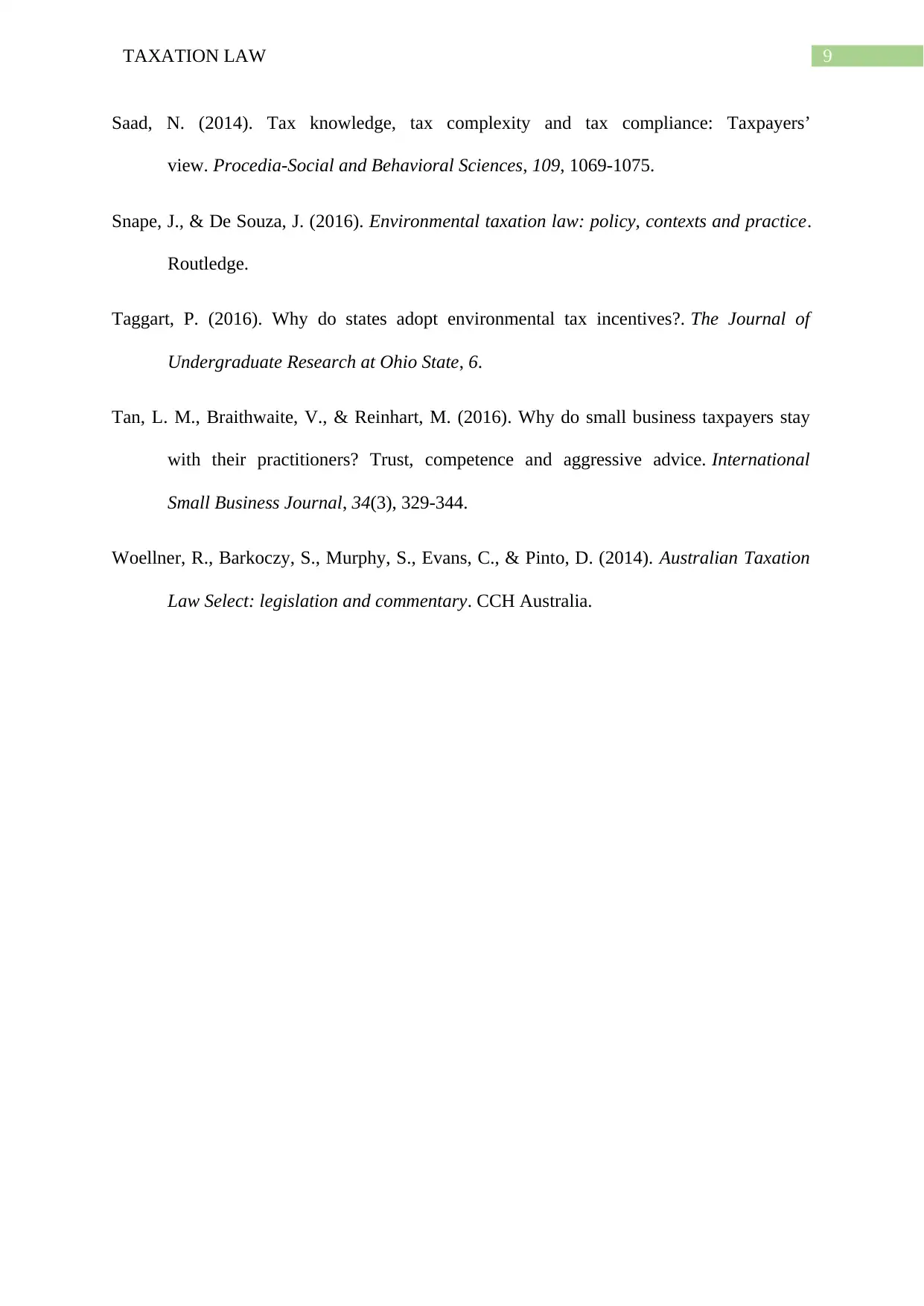
9TAXATION LAW
Saad, N. (2014). Tax knowledge, tax complexity and tax compliance: Taxpayers’
view. Procedia-Social and Behavioral Sciences, 109, 1069-1075.
Snape, J., & De Souza, J. (2016). Environmental taxation law: policy, contexts and practice.
Routledge.
Taggart, P. (2016). Why do states adopt environmental tax incentives?. The Journal of
Undergraduate Research at Ohio State, 6.
Tan, L. M., Braithwaite, V., & Reinhart, M. (2016). Why do small business taxpayers stay
with their practitioners? Trust, competence and aggressive advice. International
Small Business Journal, 34(3), 329-344.
Woellner, R., Barkoczy, S., Murphy, S., Evans, C., & Pinto, D. (2014). Australian Taxation
Law Select: legislation and commentary. CCH Australia.
Saad, N. (2014). Tax knowledge, tax complexity and tax compliance: Taxpayers’
view. Procedia-Social and Behavioral Sciences, 109, 1069-1075.
Snape, J., & De Souza, J. (2016). Environmental taxation law: policy, contexts and practice.
Routledge.
Taggart, P. (2016). Why do states adopt environmental tax incentives?. The Journal of
Undergraduate Research at Ohio State, 6.
Tan, L. M., Braithwaite, V., & Reinhart, M. (2016). Why do small business taxpayers stay
with their practitioners? Trust, competence and aggressive advice. International
Small Business Journal, 34(3), 329-344.
Woellner, R., Barkoczy, S., Murphy, S., Evans, C., & Pinto, D. (2014). Australian Taxation
Law Select: legislation and commentary. CCH Australia.
1 out of 10
Related Documents
Your All-in-One AI-Powered Toolkit for Academic Success.
+13062052269
info@desklib.com
Available 24*7 on WhatsApp / Email
![[object Object]](/_next/static/media/star-bottom.7253800d.svg)
Unlock your academic potential
Copyright © 2020–2025 A2Z Services. All Rights Reserved. Developed and managed by ZUCOL.





